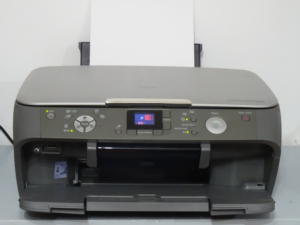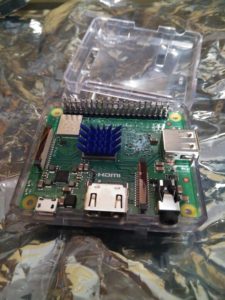Add wifi to printer!
Dear reader, I got a good but old photo-quality printer, but it was missing wireless connectivity. Even if its tradeable value is around 50 euros, it still works very well. I also avoid generation of unnecessary waste, so you might think this a “greenish” project, as a no new printer needs to be produced in China and hauled to Europe. Now, add wifi to printer!

The raspberry Pi came to rescue, bought it from Amazon for about 22 euros and 4 euros for the case. Despite being an economical option, I’m glad that the original Raspberry Pi’s are made in Sheffield, England, which still qualifies to geographical Europe.

This is a recipe how to make a wireless (WLAN/WiFi) printer and scanner from a plain USB printer/scanner. To accomplish this, a Raspberry Pi with Raspbian Linux and free server software cups and sane are used.
It’s is updated, completed and checked for Raspbian buster operating system, I have collected information from many sources as there were no single, updated source to accomplish my mission to equip a USB printer with WiFi. This is important, it saves a good printer to go prematurely to waste! You may save a tree, as you reduce the of use nonrenewable resources! Especially, if you don’t give up printing, use of computer, buying a Raspberry pi…. 😀
The journey is lenghtly, so prepare to spend a few hours with this! I’ve split the story to four parts. Easy? Yes, if you can already do something with Raspberry shell. In other words, this is for those who are past the first beginner steps, and can work with a command line. For people who see this difficult or troublesome I’d be happy to make and sell these for… say for 90 €. Hence, when you get a new printer for 90€, the project is not commercially very attractive, better to think it in DIY basis.
PART 1: PREPARE A RASPBERRY PI
Obviously, a Raspberry Pi is needed. I tried it first with a Raspberry Pi [1] B+ v1.2, the old one from 2014, but it’s sluggish on large prints and scans, so I ordered a Raspberry Pi 3 A+, which has sufficient connectivity for this application and besides, is cheap (I paid 22 € on Amazon.es).
The USB charger can be almost any that can supply real 5 V / 2.4 A of current, but I got some low voltage warnings with an insufficient cable.
If you only have a RasPi without wifi, you can use many old adapters. While two decades ago, Linux WiFi compatibility was a nightmare, it no longer is. In my stocks of old junk, I found a Linksys WUSB54GV4 “Wireless-G” WiFi adapter which is no longer detected by Windows 10 but works perfectly with Linux!
1) Hardware list
This is what I had, you may consider it a recommendation but no obligation.
- Raspberry Pi 3 A+ (other models would do as well), costs about 25 €.
- A case for the Raspberry Pi, with slots for power and USB cable. 4 – 10 €. You may use even a cardboard box.
- Phone usb Power supply 2.4 A with a good microUSB cable. Less than 10 €.
- 4 GB microSD card (I had a 8 GB, no problem), Less than 10 €.
- A USB printer-scanner, model supported by SANE: Epson Stylus Photo RX520
(Printer has to be supported by the CUPS)
(List of SANE supported scanners here: http://www.sane-project.org/sane-mfgs.html)
The acessories required to configure the conveniently the Raspberry Pi:
- Display with a HDMI input, You should have one already…
- HDMI cable or cable with HDMI adapter -> to the display type. Came with the monitor, didn’t it?
- USB keyboard (I had a Logitech K400+). Any USB keyboard will do.
- Optionally, a USB hub to if you want to connect the keyboard and the printer same time to a Raspberry Pi with one USB port same time. 10 €
At the moment, I don’t advertise or have affiliations for now (also thanks to the old-fashioned Spanish taxation system for extra income). To give a glue, where I have got the items: I often buy used stuff from CashConverteres, CeX or Ebay. You can get a new parts like Raspberry Pi and the SD card from kubii.fr, amazon.es or even Carrefour or Alcampo.
2) Download a free operating system for the Raspberry Pi
download raspbian buster lite from here: https://www.raspberrypi.org/downloads/raspbian/
3) Flash the operating system ISO image to a microSD card
For example, balenaEtcher from here: https://www.balena.io/etcher/ will do the job. Rufus is also good.
4) Connect your Raspberry Pi to peripherals
Plug in the microSD Card, connect a display via HDMI and a keyboard via USB.
Hint: there are HDMI to DVI-D and HDMI to VGA adapters to make use of old display units.
5) Add Wifi adapter if Raspberry Pi does not contain it
On a Rasberry Pi 1 type boards and some others, there is no WiFi adapter. In that case, plug in a supported WiFi adapter to a USB port.
6) Connect power
Power with 2 amp phone charger with microUSB connector.
7) Booting
Raspberry Pi should boot and you get the usual dump on your display.
8) Login from local console
Use the keyboard and display connected to the Raspberry Pi.
Login: pi Password: raspberry
These are the login and passsword after fresh installation.
9) Make first fundamental configurations to RasPi.
Configure the RPi with
sudo raspi-config
- in 4) Localization options to get the right keyboard layout (Default is US keyboard)
- At Network Options N1 you may want to give the print server a name
- You must setup WiFi network connection in Network Options N2, This way you can connect to your WLAN
- in Network Options N3 you may want to set also predictable interface names. As a result, you’ll get network interface names like wlan0.
- in Interfacing Options you may want to enable SSH access (if you don’t have an extra display or USB HUB, you’ll want to connect from your computer with e,g, PuTTY) . If you enable SSH, you should change the password for the default user pi with the command passwd
Finish raspi-config and reboot
10) Update the operating system and included software
First get updates, remember you need the wlan connection. Reboot to take the updates to use
sudo apt-get update sudo apt-get upgrade sudo reboot
The next article will show how to configure the CUPS printer server in Raspberry Pi.